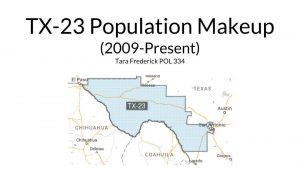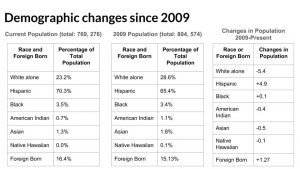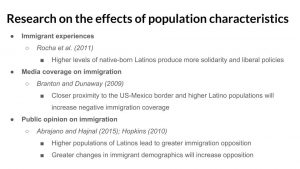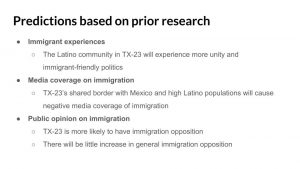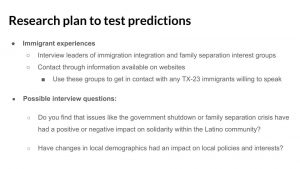Summary: For this project, I decided to write on op-ed about TX-23’s representative Will Hurd’s attempt at taking a neutral stance on immigration and how he needs to take a more forward pro-immigration standpoint. To begin, I start by explaining that Hurd is a neutral representative in very divided times. He opposes Trump’s border wall, but supports border control reform, and does not mention much else on the issue of immigration. Though he has been in office since 2015, his elections have ended with extremely small marginal differences between himself and his Democratic opponents. I argue that taking a more direct stance on immigration would increase his chances of reelection in the future. This district has a very high population of Latino citizens. This is likely to increase overall pro-immigrant support. Being pro-immigrant would give Hurd a better chance at gaining support from his largest group of constituents. Additionally, a portion of the Latino community is foreign-born. The greater the foreign-born community, the more important immigration will be in a district. If Hurd openly supported immigration, he would show to the foreign-born community that he values what issues they think are important. Lastly, local media rarely discusses the issue of immigration. When it is discussed, it is not negative. Local news articles were very objective and neutral. The little salience of the topic decreases the chances of negative media which provides less biased news sources for the TX-23 population to absorb and base their opinions off of. If for nothing else, Hurd should vocalize a pro-immigration standpoint because it may help him secure the possibility of reelection.
Op-ed:
Take a Stance: Why Will Hurd (TX-23) Needs to Show Immigration Support
The 2018 Congressional elections resulted in a shift in House power, but not all districts saw change. Will Hurd, the Republican representative of Texas’s twenty-third district has remained in office since 2015, even though each election has been incredibly close. Voters have been continuously divided, with support bouncing between Democrats and Republicans.
In today’s polarized society and divided Congress, many representatives’ platforms are based on their parties, and it is difficult to stay neutral. One of the most highly controversial, current issues is that of immigration. Many representatives have difficulty finding a balance between honoring immigrant rights, recognizing a need for border security reform, and retaining the support of their constituents in reelection.
Although moderate politicians are now scarce, TX-23’s Hurd seems to fit this profile. In regards to issues of immigration policy, Hurd has focused much of rhetoric and efforts on border security, with little actual mention of immigrants and immigration themselves. Hurd’s social media activity, website, and co-sponsored House bills show his concern for border control, bipartisan conversation, national security, and urban development within TX-23.
Hurd has also expressed his strong opposition towards President Trump’s proposed border wall. As Hurd stated in The New York Times, a technologically unprogressive wall would be “the most expensive and least effective way to do border security.” TX-23 contains a larger portion of the US-Mexico border than any other Congressional district. By recognizing a need for border security, but opposing an expensive wall, Hurd has been able to gain support from a wide range of Texan voters.
With each election, however, Hurd’s marginal difference between his Democratic opponent has been shrinking. In the 2018 election, Hurd won with 49.2% of the votes while his opponent, Gina Ortiz Jones, gained 48.7% of the district’s votes. This small difference should concern Hurd. If this gap should decrease any more in the next election, he may lose his seat in office. He has already gained immense support from his resistance to President Trump during the government shutdown and his firm opposition to the border wall, but perhaps in a modern world with such strong opinions, this is not enough. Hurd may learn the hard way that it is difficult to remain both neutral and in office.
It seems as though Hurd has two options, both of which are backed by the same idea. He has to take a more well-defined stance on immigration. He can either present himself from an anti-immigrant standpoint to gain more Republican, working class support, or he can take a pro-immigrant attitude to secure Latino, foreign-born voter support. Based on the demographics and media perspectives in TX-23, it would be in Hurd’s best interest to take a pro-immigrant and pro-immigration stand.
TX-23 if 70% Latino. Research has shown that as a whole, higher concentrations of Latino populations increase immigration support. In 2013, Jason P. Casellas and David L. Leal published the study “Partisanship or population? House and Senate immigration votes in the 109th and 110th Congresses” which described the relationships between immigration policy making and different demographic factors. They explain that higher Latino populations are more likely to favor liberal immigration policy because there is a greater cultural understanding and solidarity. The article also states that partisanship is the greatest influence in policy support. By this logic, Hurd could earn Latino backing from a pro-immigrant platform, and still gain support from party loyalty since 48% of the district consists of Republican voters.
Roughly 16% of this Latino population is foreign born. According to Carrie Skulley’s work “Majority rule vs. minority rights: immigrant representation despite public opposition on the 1986 immigration reform and control act,” higher levels of foreign-born populations are likely to increase the importance of immigration policies. Though 16% may not seem like a large proportion, this is a much higher number of immigrants than other districts. This would give Hurd more incentive to embrace pro-immigrant attitudes.
Furthermore, Representative Hurd should show pro-immigration attitudes because of the districts’ media patterns. Surprisingly, immigration is not a hot topic in local media. During the government shutdown from December 11, 2018 to January 31, 2019, the word “border” was only mentioned in four articles in The Alpine Avalanche, one of the larger local newspapers in TX-23, and the word “shutdown” was only used in one article. The articles which did mention immigration-related issues were not overwhelmingly negative. In fact, many of the articles were fairly objective and neutral. This corresponds with Daniel J. Hopkins’ article “Politicized Places: Explaining Where and When Immigrants Provoke Local Opposition” which explains a higher salience of immigration in the media usually leads to more negative coverage. TX-23 has a special opportunity in that immigration’s low salience in local news means that the district is not as affected by overly-biased, negative media.
If Hurd was to assume a strong anti-immigrant standpoint, a lack of negative media would not back his position. Media has a strong influence on the public’s perceptions and political decision-making, as well as how a representative chooses to act on certain issues. Having a neutral local media, when a majority of national news is generally left-leaning, would not support an anti-immigrant policy agenda when many constituents are already in support of the issue.
Hurd is already known as one of the few Republicans who opposes President Trump and some of his more conservative ideas. In addition, Hurd is known for trying to make the TX-23 community and his services available and accessible to the Latino community, where much of his support stems from. His entire website is in both English and Spanish for his Spanish-speaking constituents. Voicing more direct support of immigration would not be a surprise, nor would be going against many of the policies and ideas that he already supports. Like any other congressional representative, Hurd is concerned with reelection. In order to secure more votes in 2020, he should take a stronger position on immigration. Based on the concerns, demographics, and local media of his district, Hurd should vocally support immigration.





